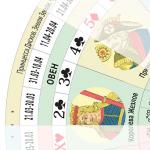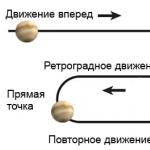Constant avogadro. Where is the Avogadro number used?
The Italian scientist Amedeo Avogadro, a contemporary of A. S. Pushkin, was the first to understand that the number of atoms (molecules) in one gram-atom (mole) of a substance is the same for all substances. Knowledge of this number opens the way to estimating the size of atoms (molecules). During the life of Avogadro, his hypothesis did not receive due recognition. The history of the Avogadro number is dedicated A new book Evgeniy Zalmanovich Meilikhov, professor at the Moscow Institute of Physics and Technology, chief researcher at the National Research Center “Kurchatov Institute”.
If, as a result of some world catastrophe, all the accumulated knowledge would be destroyed and only one phrase would come to the future generations of living beings, then what statement, composed of the smallest number of words, would bring the most information? I believe this is the atomic hypothesis:<...>all bodies are made up of atoms - small bodies that are in constant motion.
R. Feynman, "The Feynman Lectures on Physics"
The Avogadro number (Avogadro's constant, Avogadro's constant) is defined as the number of atoms in 12 grams of the pure isotope carbon-12 (12 C). It is usually denoted as N A, less often L. The value of the Avogadro number recommended by CODATA (working group on fundamental constants) in 2015: N A = 6.02214082(11) 1023 mol −1 . A mole is the amount of a substance that contains N A structural elements (that is, as many elements as there are atoms in 12 g 12 C), and the structural elements are usually atoms, molecules, ions, etc. By definition, the atomic mass unit (amu) is 1/12 the mass of a 12 C atom. One mole (gram-mol) of a substance has a mass (molar mass) that, when expressed in grams, is numerically equal to the molecular weight of that substance (expressed in atomic mass units). For example: 1 mol of sodium has a mass of 22.9898 g and contains (approximately) 6.02 10 23 atoms, 1 mol of calcium fluoride CaF 2 has a mass of (40.08 + 2 18.998) = 78.076 g and contains (approximately) 6 .02 10 23 molecules.
At the end of 2011, at the XXIV General Conference on Weights and Measures, a proposal was unanimously adopted to define the mole in a future version of the International System of Units (SI) in such a way as to avoid its linkage to the definition of the gram. It is assumed that in 2018 the mole will be determined directly by the Avogadro number, which will be assigned an exact (without error) value based on the measurement results recommended by CODATA. So far, the Avogadro number is not accepted by definition, but a measured value.
This constant is named after the famous Italian chemist Amedeo Avogadro (1776–1856), who, although he himself did not know this number, understood that it was a very large value. At the dawn of the development of atomic theory, Avogadro put forward a hypothesis (1811), according to which, at the same temperature and pressure, equal volumes of ideal gases contain the same number of molecules. Later it was shown that this hypothesis is a consequence kinetic theory gases, and is now known as Avogadro's law. It can be formulated as follows: one mole of any gas at the same temperature and pressure occupies the same volume, under normal conditions equal to 22.41383 liters (normal conditions correspond to pressure P 0 = 1 atm and temperature T 0 = 273.15 K). This quantity is known as the molar volume of the gas.
The first attempt to find the number of molecules occupying a given volume was made in 1865 by J. Loschmidt. It followed from his calculations that the number of molecules per unit volume of air is 1.8 10 18 cm −3, which, as it turned out, is about 15 times less correct value. Eight years later, J. Maxwell gave an estimate much closer to the truth - 1.9 · 10 19 cm −3 . Finally, in 1908, Perrin gives an already acceptable assessment: N A = 6.8 10 23 mol −1 Avogadro's number, found from experiments on Brownian motion.
Since then, a large number of independent methods have been developed to determine the Avogadro number, and more accurate measurements have shown that in reality there are (approximately) 2.69 x 10 19 molecules in 1 cm 3 of an ideal gas under normal conditions. This quantity is called the Loschmidt number (or constant). It corresponds to Avogadro's number N A ≈ 6.02 10 23 .
Avogadro's number is one of the important physical constants that played an important role in the development of the natural sciences. But is it a "universal (fundamental) physical constant"? The term itself is not defined and is usually associated with a more or less detailed table of the numerical values of physical constants that should be used in solving problems. In this regard, the fundamental physical constants are often considered those quantities that are not constants of nature and owe their existence only to the chosen system of units (such, for example, the magnetic and electric vacuum constants) or conditional international agreements (such, for example, the atomic mass unit) . The fundamental constants often include many derived quantities (for example, the gas constant R, the classical electron radius r e= e 2 / m e c 2 etc.) or, as in the case of molar volume, the value of some physical parameter related to specific experimental conditions, which are chosen only for reasons of convenience (pressure 1 atm and temperature 273.15 K). From this point of view, the Avogadro number is a truly fundamental constant.
This book is devoted to the history and development of methods for determining this number. The epic lasted for about 200 years and different stages was associated with a variety of physical models and theories, many of which have not lost their relevance to this day. The brightest scientific minds had a hand in this story - suffice it to name A. Avogadro, J. Loschmidt, J. Maxwell, J. Perrin, A. Einstein, M. Smoluchovsky. The list could go on and on...
The author must admit that the idea of the book does not belong to him, but to Lev Fedorovich Soloveichik, his classmate at the Moscow Institute of Physics and Technology, a man who was engaged in applied research and development, but remained a romantic physicist at heart. This is a person who (one of the few) continues “even in our cruel age” to fight for a real “higher” physical education in Russia, appreciates and, to the best of his ability, promotes the beauty and elegance of physical ideas. It is known that from the plot, which A. S. Pushkin presented to N. V. Gogol, a brilliant comedy arose. Of course, this is not the case here, but perhaps this book will also be useful to someone.
This book is not a "popular science" work, although it may seem so at first glance. In it for some historical background serious physics is discussed, serious mathematics is used, and rather complex scientific models are discussed. In fact, the book consists of two (not always sharply demarcated) parts, designed for different readers - some may find it interesting from a historical and chemical point of view, while others may focus on the physical and mathematical side of the problem. The author had in mind an inquisitive reader - a student of the Faculty of Physics or Chemistry, not alien to mathematics and passionate about the history of science. Are there such students? The author does not know the exact answer to this question, but, based on his own experience, he hopes that there is.
Introduction (abbreviated) to the book: Meilikhov EZ Avogadro's number. How to see an atom. - Dolgoprudny: Publishing House "Intellect", 2017.
> Avogadro's number
Find out what is Avogadro's number in prayers. Study the ratio of the amount of substance of molecules and the Avogadro number, Brownian motion, gas constant and Faraday.
The number of molecules in a mole is called the Avogadro number, which is 6.02 x 10 23 mol -1.
Learning task
- Understand the relationship between Avogadro's number and moles.
Key Points
- Avogadro suggested that in the case of uniform pressure and temperature, equal gas volumes contain the same number of molecules.
- The Avogadro constant is an important factor, as it links other physical constants and properties.
- Albert Einstein believed that this number could be derived from the quantities of Brownian motion. It was first measured in 1908 by Jean Perrin.
Terms
- The gas constant is the universal constant (R) resulting from the ideal gas law. It is extracted from the Boltzmann constant and the Avogadro number.
- Faraday's constant is the amount of electric charge per mole of electrons.
- Brownian motion is the random displacement of elements formed due to impacts with individual molecules in a liquid.
If you are faced with a change in the amount of a substance, then it is easier to use a unit other than the number of molecules. The mole is the basic unit in the international system and conveys a substance containing as many atoms as is stored in 12 g of carbon-12. This amount of substance is called Avogadro's number.
He managed to establish a relationship between the masses of the same volume of different gases (under conditions of the same temperature and pressure). This contributes to the relationship of their molecular weights
The Avogadro number conveys the number of molecules in one gram of oxygen. Do not forget that this is an indication of the quantitative characteristic of a substance, and not an independent measurement size. In 1811, Avogadro guessed that the volume of a gas can be proportional to the number of atoms or molecules, and this will not be affected by the nature of the gas (the number is universal).
Jean Perinne won the Nobel Prize in Physics in 1926 for deriving Avogadro's constant. So Avogadro's number is 6.02 x 10 23 mol -1.
scientific significance
The Avogadro constant plays the role of an important link in macro- and microscopic natural observations. It kind of builds a bridge for other physical constants and properties. For example, establishes a relationship between the gas constant (R) and Boltzmann (k):
R = kN A = 8.314472 (15) J mol -1 K -1 .
And also between the Faraday constant (F) and the elementary charge (e):
F = N A e = 96485.3383 (83) C mol -1 .
Constant calculation
The definition of the number affects the calculation of the mass of an atom, which is obtained by dividing the mass of a mole of gas by Avogadro's number. In 1905, Albert Einstein suggested deriving it based on the magnitudes of Brownian motion. It was this idea that Jean Perrin tested in 1908.
N A = 6.022 141 79(30)×10 23 mol −1 .Avogadro's Law
At the dawn of the development of atomic theory (), A. Avogadro put forward a hypothesis according to which, at the same temperature and pressure, equal volumes of ideal gases contain the same number of molecules. This hypothesis was later shown to be a necessary consequence of the kinetic theory, and is now known as Avogadro's law. It can be formulated as follows: one mole of any gas at the same temperature and pressure occupies the same volume, under normal conditions equal to 22,41383 . This quantity is known as the molar volume of the gas.
Avogadro himself did not make estimates of the number of molecules in a given volume, but he understood that this was a very large quantity. The first attempt to find the number of molecules occupying a given volume was made by J. Loschmidt; it was found that 1 cm³ of an ideal gas under normal conditions contains 2.68675 10 19 molecules. By the name of this scientist, the indicated value was called the Loschmidt number (or constant). Since then, a large number of independent methods for determining the Avogadro number have been developed. The excellent agreement of the obtained values is a convincing evidence of the real existence of molecules.
Relationship between constants
- Through the product of the Boltzmann constant, the Universal gas constant, R=kN A.
- Through the product of an elementary electric charge and the Avogadro number, the Faraday constant is expressed, F=en A.
see also
Wikimedia Foundation. 2010 .
See what the "Avogadro constant" is in other dictionaries:
Avogadro's constant- Avogadro konstanta statusas T sritis Standartizacija ir metrologija apibrėžtis Apibrėžtį žr. priede. priedas(ai) Grafinis formatas atitikmenys: engl. Avogadro constant vok. Avogadro Konstante, f; Avogadrosche Konstante, f rus. Avogadro's constant... Penkiakalbis aiskinamasis metrologijos terminų žodynas
Avogadro's constant- Avogadro konstanta statusas T sritis fizika atitikmenys: engl. Avogadro's constant; Avogadro's number vok. Avogadro Konstante, f; Avogadrosche Konstante, f rus. Avogadro's constant, f; Avogadro's number, n pranc. constante d'Avogadro, f; nombre… … Fizikos terminų žodynas
Avogadro's constant- Avogadro konstanta statusas T sritis Energetika apibrėžtis Apibrėžtį žr. priede. priedas(ai) MS Word formatas atitikmenys: engl. Avogadro's constant vok. Avogadro Konstante, f; Avogadrosche Konstante, f rus. Avogadro's constant, f; constant... ... Aiškinamasis šiluminės ir branduolinės technikos terminų žodynas
- (Avogadro number) (NA), the number of molecules or atoms in 1 mole of a substance; NA \u003d 6.022? 1023 mol 1. Named after A. Avogadro ... Modern Encyclopedia
Avogadro constant- (Avogadro number) (NA), the number of molecules or atoms in 1 mole of a substance; NA=6.022´1023 mol 1. Named after A. Avogadro. … Illustrated Encyclopedic Dictionary
Avogadro Amedeo (08/09/1776, ‒ 07/09/1856, ibid.), Italian physicist and chemist. He received a law degree, then studied physics and mathematics. Corresponding member (1804), ordinary academician (1819), and then director of the department ... ...
- (Avogadro) Amedeo (08/09/1776, Turin, 07/09/1856, ibid.), Italian physicist and chemist. He received a law degree, then studied physics and mathematics. Corresponding member (1804), ordinary academician (1819), and then director of the department of physics ... ... Great Soviet Encyclopedia
The fine structure constant, usually denoted as, is a fundamental physical constant that characterizes the strength of the electromagnetic interaction. It was introduced in 1916 by the German physicist Arnold Sommerfeld as a measure ... ... Wikipedia
- (Avogadro's number), the number of structural elements (atoms, molecules, ions or other h c) in units. count va to va (in one mole). Named after A. Avogadro, designated NA. A. p. one of the fundamental physical constants, essential for determining many ... Physical Encyclopedia
CONSTANT- a value that has a constant value in the area of its use; (1) P. Avogadro is the same as Avogadro (see); (2) P. Boltzmann is a universal thermodynamic quantity that connects the energy of an elementary particle with its temperature; denoted by k,… … Great Polytechnic Encyclopedia
Books
- Biographies of physical constants. Fascinating stories about universal physical constants. Issue 46
- Biographies of physical constants. Fascinating stories about universal physical constants, O. P. Spiridonov. This book is devoted to the consideration of universal physical constants and their important role in the development of physics. The task of the book is to tell in a popular form about the appearance in the history of physics ...
Avogadro's Law
At the dawn of the development of atomic theory (), A. Avogadro put forward a hypothesis according to which, at the same temperature and pressure, equal volumes of ideal gases contain the same number of molecules. This hypothesis was later shown to be a necessary consequence of the kinetic theory, and is now known as Avogadro's law. It can be formulated as follows: one mole of any gas at the same temperature and pressure occupies the same volume, under normal conditions equal to 22,41383 . This quantity is known as the molar volume of the gas.
Avogadro himself did not make estimates of the number of molecules in a given volume, but he understood that this is a very large value. The first attempt to find the number of molecules occupying a given volume was made in the year J. Loschmidt. It followed from Loschmidt's calculations that for air the number of molecules per unit volume is 1.81 10 18 cm −3, which is about 15 times less true value. After 8 years, Maxwell gave a much closer estimate of "about 19 million million million" molecules per cubic centimeter, or 1.9·10 19 cm −3 . In fact, 1 cm³ of an ideal gas under normal conditions contains 2.68675·10 19 molecules. This quantity has been called the Loschmidt number (or constant). Since then, a large number of independent methods for determining the Avogadro number have been developed. The excellent agreement of the obtained values is a convincing evidence of the real number of molecules.
Constant measurement
| Data in this article is current as of December 2011. |
The officially accepted value of Avogadro's number today was measured in 2010. For this, two spheres made of silicon-28 were used. The spheres were obtained at the Leibniz Institute of Crystallography and polished at the Australian Center for High Precision Optics so smoothly that the heights of protrusions on their surface did not exceed 98 nm. For their production, high-purity silicon-28 was used, isolated at the Nizhny Novgorod Institute of Chemistry of High-Purity Substances of the Russian Academy of Sciences from silicon tetrafluoride highly enriched in silicon-28, obtained at the Central Design Bureau of Mechanical Engineering in St. Petersburg.
Having such practically ideal objects, it is possible to count with high accuracy the number of silicon atoms in the ball and thereby determine the Avogadro number. According to the results obtained, it is equal to 6.02214084(18)×10 23 mol −1 .
Relationship between constants
- Through the product of the Boltzmann constant, the Universal gas constant, R=kN A.
- Through the product of an elementary electric charge and the Avogadro number, the Faraday constant is expressed, F=en A.
see also
Notes
Literature
- Avogadro's number // Great Soviet Encyclopedia
Wikimedia Foundation. 2010 .
See what "Avogadro's Number" is in other dictionaries:
- (Avogadro's constant, symbol L), a constant equal to 6.022231023, corresponds to the number of atoms or molecules contained in one MOL of a substance ... Scientific and technical encyclopedic dictionary
Avogadro's number- Avogadro konstanta statusas T sritis chemija apibrėžtis Dalelių (atomų, molekulių, jonų) skaičius viename medžiagos molyje, lygus (6.02204 ± 0.000031) 10²³ mol⁻¹. santrumpa(os) Santrumpą žr. priede. priedas(ai) Grafinis formatas atitikmenys:… … Chemijos terminų aiskinamasis žodynas
Avogadro's number- Avogadro konstanta statusas T sritis fizika atitikmenys: engl. Avogadro's constant; Avogadro's number vok. Avogadro Konstante, f; Avogadrosche Konstante, f rus. Avogadro's constant, f; Avogadro's number, n pranc. constante d'Avogadro, f; nombre… … Fizikos terminų žodynas
Avogadro constant (Avogadro number)- the number of particles (atoms, molecules, ions) in 1 mole of a substance (a mole is the amount of a substance that contains as many particles as there are atoms in exactly 12 grams of the carbon 12 isotope), denoted by the symbol N = 6.023 1023. One of ... ... Beginnings of modern natural science
- (Avogadro's number), the number of structural elements (atoms, molecules, ions or other h c) in units. count va to va (in one mole). Named after A. Avogadro, designated NA. A. p. one of the fundamental physical constants, essential for determining many ... Physical Encyclopedia
- (Avogadro's number; denoted by NA), the number of molecules or atoms in 1 mole of a substance, NA \u003d 6.022045 (31) x 1023 mol 1; name named A. Avogadro ... Natural science. encyclopedic Dictionary
- (Avogadro's number), the number of particles (atoms, molecules, ions) in 1 mole in VA. Denoted NA and equal to (6.022045 ... Chemical Encyclopedia
Na \u003d (6.022045 ± 0.000031) * 10 23 the number of molecules in a mole of any substance or the number of atoms in a mole of a simple substance. One of the fundamental constants, with which you can determine such quantities as, for example, the mass of an atom or molecule (see ... ... Collier Encyclopedia
A physical quantity equal to the number of structural elements (which are molecules, atoms, etc.) per one mole of a substance is called Avogadro's number. Its currently officially accepted value is NA = 6.02214084(18)×1023 mol −1, it was approved in 2010. In 2011, the results of new studies were published, they are considered more accurate, but this moment not officially approved.
Avogadro's law is of great importance in the development of chemistry, he allowed to calculate the weight of bodies that can change state, becoming gaseous or vaporous. It was on the basis of Avogadro's law that the atomic-molecular theory, which follows from the kinetic theory of gases, began its development.
Moreover, with the help of Avogadro's law, a method has been developed to obtain the molecular weight of solutes. To do this, the laws of ideal gases were extended to dilute solutions, based on the idea that the solute will be distributed over the volume of the solvent, as the gas is distributed in the vessel. Also, Avogadro's law made it possible to determine the true atomic masses a range of chemical elements.
Practical use of Avogadro's number
The constant is used in the calculation of chemical formulas and in the process of compiling equations of chemical reactions. With the help of it, the relative molecular masses of gases and the number of molecules in one mole of any substance are determined.
Through the Avogadro number, the universal gas constant is calculated, it is obtained by multiplying this constant by the Boltzmann constant. In addition, by multiplying the Avogadro number and the elementary electric charge, one can obtain the Faraday constant.
Using the consequences of Avogadro's law
The first consequence of the law says: "One mole of gas (any) under equal conditions will occupy one volume." Thus, under normal conditions, the volume of one mole of any gas is 22.4 liters (this value is called the molar volume of gas), and using the Mendeleev-Clapeyron equation, you can determine the volume of gas at any pressure and temperature.
The second consequence of the law: "The molar mass of the first gas is equal to the product of the molar mass of the second gas by the relative density of the first gas to the second." In other words, under the same conditions, knowing the ratio of the density of two gases, one can determine their molar masses.
At the time of Avogadro, his hypothesis was theoretically unprovable, but it made it easy to experimentally establish the composition of gas molecules and determine their mass. Over time, a theoretical basis was brought under his experiments, and now Avogadro's number is used






